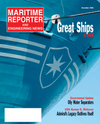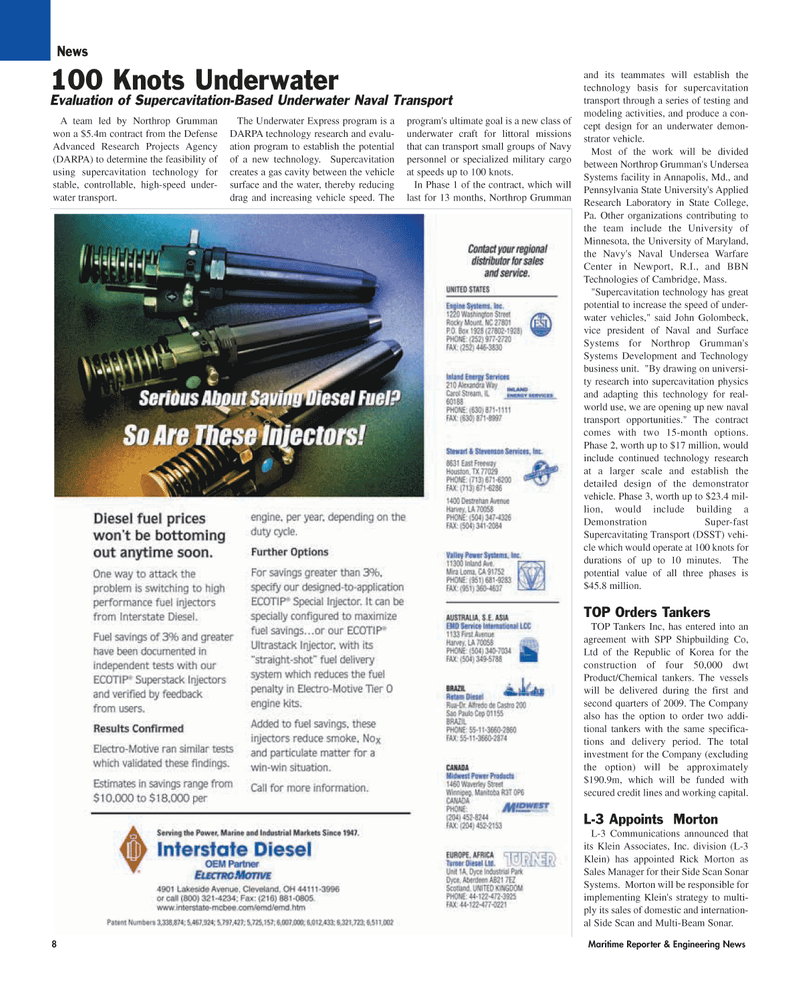
Page 8: of Maritime Reporter Magazine (December 2, 2006)
Read this page in Pdf, Flash or Html5 edition of December 2, 2006 Maritime Reporter Magazine
8 Maritime Reporter & Engineering News
A team led by Northrop Grumman won a $5.4m contract from the Defense
Advanced Research Projects Agency (DARPA) to determine the feasibility of using supercavitation technology for stable, controllable, high-speed under- water transport.
The Underwater Express program is a
DARPA technology research and evalu- ation program to establish the potential of a new technology. Supercavitation creates a gas cavity between the vehicle surface and the water, thereby reducing drag and increasing vehicle speed. The program's ultimate goal is a new class of underwater craft for littoral missions that can transport small groups of Navy personnel or specialized military cargo at speeds up to 100 knots.
In Phase 1 of the contract, which will last for 13 months, Northrop Grumman and its teammates will establish the technology basis for supercavitation transport through a series of testing and modeling activities, and produce a con- cept design for an underwater demon- strator vehicle.
Most of the work will be divided between Northrop Grumman's Undersea
Systems facility in Annapolis, Md., and
Pennsylvania State University's Applied
Research Laboratory in State College,
Pa. Other organizations contributing to the team include the University of
Minnesota, the University of Maryland, the Navy's Naval Undersea Warfare
Center in Newport, R.I., and BBN
Technologies of Cambridge, Mass. "Supercavitation technology has great potential to increase the speed of under- water vehicles," said John Golombeck, vice president of Naval and Surface
Systems for Northrop Grumman's
Systems Development and Technology business unit. "By drawing on universi- ty research into supercavitation physics and adapting this technology for real- world use, we are opening up new naval transport opportunities." The contract comes with two 15-month options.
Phase 2, worth up to $17 million, would include continued technology research at a larger scale and establish the detailed design of the demonstrator vehicle. Phase 3, worth up to $23.4 mil- lion, would include building a
Demonstration Super-fast
Supercavitating Transport (DSST) vehi- cle which would operate at 100 knots for durations of up to 10 minutes. The potential value of all three phases is $45.8 million.
TOP Orders Tankers
TOP Tankers Inc, has entered into an agreement with SPP Shipbuilding Co,
Ltd of the Republic of Korea for the construction of four 50,000 dwt
Product/Chemical tankers. The vessels will be delivered during the first and second quarters of 2009. The Company also has the option to order two addi- tional tankers with the same specifica- tions and delivery period. The total investment for the Company (excluding the option) will be approximately $190.9m, which will be funded with secured credit lines and working capital.
L-3 Appoints Morton
L-3 Communications announced that its Klein Associates, Inc. division (L-3
Klein) has appointed Rick Morton as
Sales Manager for their Side Scan Sonar
Systems. Morton will be responsible for implementing Klein's strategy to multi- ply its sales of domestic and internation- al Side Scan and Multi-Beam Sonar.
News 100 Knots Underwater
Evaluation of Supercavitation-Based Underwater Naval Transport
MR DECEMBER2006 #1 (1-8).qxd 12/5/2006 1:12 PM Page 10

 7
7

 9
9
